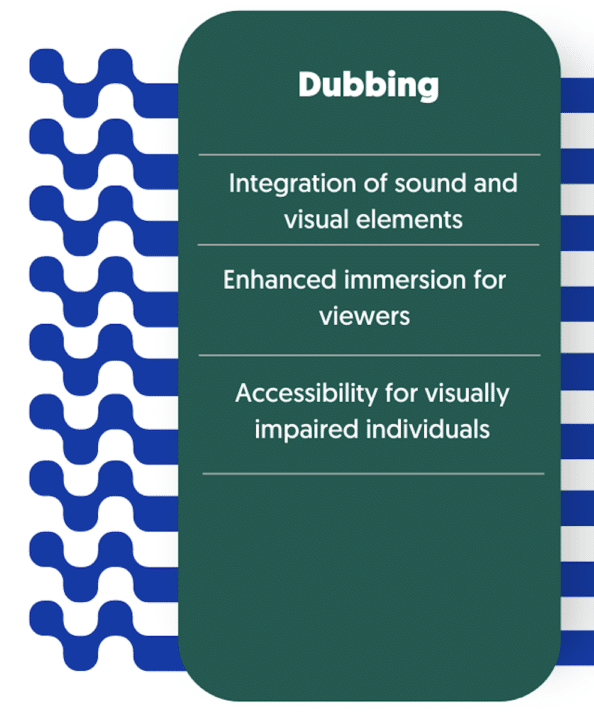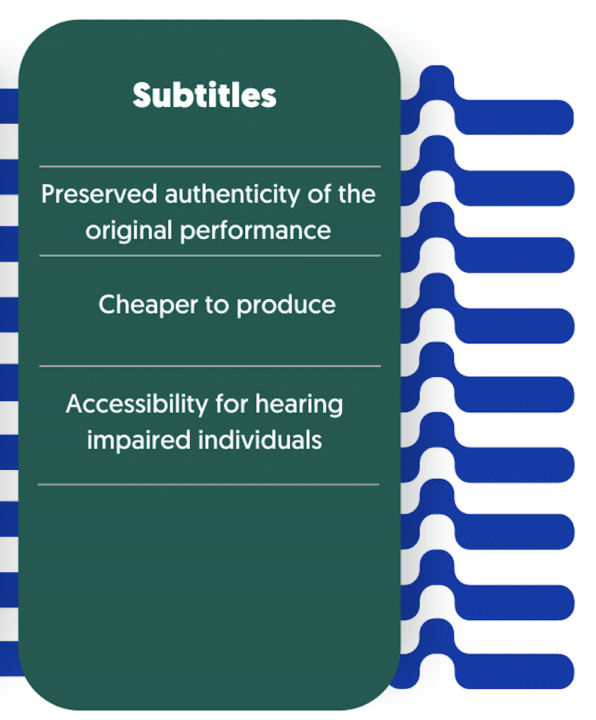In an increasingly globalized world, where cultures and languages intermingle, the need for effective audiovisual translation has become paramount. Audiovisual translation (AVT) is the process of taking a source audiovisual text and translating it into another language. There are two main types of AVT, dubbing and subtitles: dubbing is when spoken dialogue is dubbed over in a new language, while subtitles refer to the written on-screen translation of the original dialogue.
The question arises: Are both dubbing and subtitles necessary for translation, or does one method suffice? In this article, we’ll explore both techniques in more detail, and we’ll try to answer that question. Let’s get started.
Table of contents:
Dubbing: Pros and Cons
Dubbing is the practice of combining audio from the target language with the original visuals, in order to give viewers an immersive experience. This translation method provides several advantages, including:
Enabling viewers to focus on visuals and emotions
With dubbing, viewers no longer need to read subtitles while also paying attention to the visual elements of a film or show. This can allow them to better appreciate the story, as they can focus entirely on the visuals and emotions rather than reading at the same time. This is especially beneficial for individuals who prefer an immersive audio experience or find it challenging to read subtitles quickly.
Enhanced accessibility for viewers who prefer audio over reading
Some viewers have visual impairments or reading difficulties, or maybe they simply find it easier to absorb information when it’s spoken, rather than having to read subtitles. Dubbing can make the content more accessible for these viewers, which could be beneficial in terms of audience engagement.
Enhanced immersive experience
Dubbing can create a more immersive viewing experience for audiences by making them feel like they are part of the story. Voice actors can add emotion and nuance that would not be present with subtitles, allowing viewers to identify strongly with certain characters or situations.

Despite these benefits, dubbing also comes with certain drawbacks. Some of the main concerns are:
Potential loss of original dialogue and cultural nuances
When dubbing is done incorrectly, it can lead to a loss of the original dialogue or cultural nuances present in the original version. It’s important for translators and voice actors to be aware of these aspects when translating so that they are not inadvertently altered.
Challenge of synchronizing lip movements and maintaining authenticity
Dubbing requires careful timing in order to ensure that the lip movements match the audio. Otherwise, viewers may feel disconnected from what’s happening on screen. This makes it difficult to achieve a high degree of authenticity with dubbing unless done very carefully.
Limited availability of voice actors and production costs
Dubbing is often more expensive than subtitles due to its greater level of complexity: hiring professional voice actors, recording studios, and production teams can significantly impact one’s budget. Furthermore, there is a limited pool of voice actors available to dub films and TV shows, which can make it difficult to recreate the original performance.
Overall, dubbing has both advantages and disadvantages that should be taken into consideration when deciding between dubbing or subtitles. It may be beneficial for certain viewers, but not all content may benefit from using this method. Ultimately, the decision will depend on the specific project and budget constraints.

Find out more about our dubbing solutions
Find out moreSubtitles: Pros and Cons
Subtitles, on the other hand, provide a written translation of the dialogue displayed on the screen, allowing audiences in different countries to enjoy a film or show. There are, however, some advantages and disadvantages associated with them. Let’s explore the pros and cons of subtitles.
Preserve the original dialogue and cultural context
The main advantage of using subtitles is that they preserve the original dialogue and cultural context without relying on dubbing actors from another language. This means viewers get to hear the authentic performances, intonations, and voices of the actors, enabling a closer connection to the original production. Subtitles also allow for the inclusion of cultural references, idiomatic expressions, and wordplay that might otherwise be lost in the dubbing process.
Cheaper and faster to produce compared to dubbing
Producing subtitles is cheaper, faster and overall more efficient than hiring a different cast for dubbed versions. Since they involve translating the dialogue and syncing it with the visuals, the overall cost and time required for subtitle production are significantly reduced. This makes subtitles a more accessible option for smaller production studios or independent filmmakers with limited resources.
Enhanced accessibility for hearing impaired individuals
Subtitles provide an additional benefit in terms of accessibility for individuals with hearing impairments. By displaying the translated text on the screen, subtitles enable hearing-impaired viewers to follow the dialogue and fully engage with the content. This inclusivity aspect is a crucial advantage of subtitles, allowing a broader audience to enjoy audiovisual material.

On the other hand, subtitles have some drawbacks as well. Firstly, they require the viewer to read while watching which can be distracting and take away from their visual attention. Secondly, translations can be condensed or simplified for readability which might lead to missing out on nuances in the language. Finally, subtitles may not be accessible to illiterate or visually impaired viewers who cannot follow the text due to a language barrier. Relying solely on written text can exclude certain audiences who may not have access to or benefit from subtitles as a means of translation.
Knowing about the advantages and disadvantages of subtitles is crucial if you’re considering using them when translating your content. In the next sections, we will further explore the contextual factors that influence the choice between dubbing and subtitles and examine the evolving techniques and hybrid approaches in audiovisual translation.
Contextual Factors in Choosing Dubbing or Subtitles
When deciding between dubbing or subtitles for a film, there are several contextual factors to take into account. First, it’s important to analyze the target audience and their preferences. For example, some viewers may have a strong preference for dubbing due to their familiarity with the practice or a preference for an immersive audio experience. Others may prefer subtitles, appreciating the authenticity of the original performances and the opportunity to hear the actors’ voices..
Second, cultural and linguistic aspects of the source material should be taken into consideration. Is the original language likely to be understood by all members of the target audience? If not, dubbing may be necessary in order to make sure everyone can understand what is being said; this is the case with content aimed at younger viewers who may struggle with reading subtitles or for genres where visual elements are more critical than linguistic accuracy. However, certain films or TV shows heavily rely on cultural references, wordplay, or specific dialects, making subtitles a more suitable option for retaining those nuances.
Lastly, practical constraints and budget limitations need to be explored as well. Dubbing requires a substantial investment due to the work required for translation and voice-over artists, recording studios, and post-production facilities, which may not be feasible for smaller productions with limited resources. Ultimately, a combination of dubbing and subtitles may be the best option for reaching the right audience and remaining within budget.
The Evolution of Translation Techniques
Over the years, audiovisual translation techniques have undergone significant evolution, driven by advancements in technology and changing audience preferences. While dubbing and subtitles have been the primary methods, alternative approaches have emerged, making it easier for us to consume and understand global content. From silent movies with intertitles, to post-synchronized dubbing, and now emerging voice-over narration, simultaneous translation techniques, and machine translation powered by AI – the development of these solutions has enabled an unprecedented level of international access to media.
In recent times, new technologies and alternative methods for translating media are emerging:
- Voice-over narration involves adding a narrator’s voice to the original soundtrack, providing a translation alongside the original audio, preserving those nuances that could have been lost through dubbing alone. Voice-over narration can be effective for documentaries, interviews, or other content where maintaining the authenticity of the original voices is crucial.
- Simultaneous translation techniques, often seen in live events or conferences, use natural language processing (NLP) and AI algorithms such as machine translation to produce near real-time interpretations of the audio – making it possible for those who speak different languages to interact without having to switch languages and interrupt the flow of the dialogue.
- Machine translation has seen major advances in recent years. Powered by AI and deep learning algorithms, machine translations are quickly advancing and reaching levels that make it possible to streamline the translation process by automating the generation of subtitles or even providing real-time dubbing. However, challenges remain in achieving linguistic accuracy, maintaining the nuances of the original content, and overcoming the limitations of machine-generated translations.
As we move into a new era of increased global connectivity, the evolution of translation techniques will continue to be a key factor in creating accessible media content worldwide. Hybrid approaches combining dubbing and subtitles are also gaining traction, aiming to strike a balance between the advantages of both techniques.
In the following section, we will explore successful examples of hybrid approaches and delve into the benefits, challenges, and limitations they present in the audiovisual translation landscape.

Get a customized offer
Request a quote to translate subtitles
Finding the Right Balance: Hybrid Approaches
Finding the right balance between dubbed versions and subtitled versions of content can be daunting. Fortunately, hybrid approaches to language-customization offer a wide range of solutions for striking that balance.
For example, a film may utilize dubbing for main characters to enhance emotional engagement while using subtitles for background dialogue to maintain linguistic accuracy. Hybrid approaches allow for a tailored translation experience that considers the unique requirements of each project and target audience.
Combining dubbing and subtitles also has many benefits; it allows producers to customize content to target particular audiences, preserve the original audio elements of a production, and create engaging experiences for international viewers. This method also allows for greater flexibility when it comes to language translation; producers can choose different languages in which to dub or subtitle their content.
Despite its benefits, hybrid approaches do have some limitations. It can be difficult to achieve perfect synchronization between the dubbing and subtitles. Additionally, costs may increase due to additional time spent on translations and sync issues that arise from combining dubbing and subtitles. Even with these challenges, however, hybrid approaches offer great potential for customizing content and making it more accessible for global audiences.
In conclusion, it is clear that both dubbing and subtitles have their place in audiovisual translation, and the choice between the two depends on various factors. Considering audience preferences, cultural context, and practical constraints is crucial in determining the most appropriate translation method. Furthermore, as audiovisual translation techniques evolve, hybrid approaches have emerged as a promising solution to merge these two great methods.
Ultimately, the goal of audiovisual translation is to bridge linguistic and cultural gaps, making content accessible and enjoyable for a diverse range of viewers. By carefully weighing the pros and cons of dubbing and subtitles and embracing innovative approaches, we can strive to create more inclusive and engaging audiovisual experiences in an increasingly interconnected world.